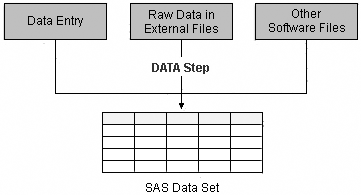Storing Data in SAS Data Sets
Overview
In many
cases, it is best practice for you to store data in SAS data sets.
You can optimize performance if you know when you should create a
SAS data set and when you should read data directly from an external
file.
Before viewing the comparative
example that illustrates different techniques for reading from a SAS
data set versus from an external file, consider the following advantages
of storing data in SAS data sets.
When you use SAS to
repeatedly analyze or manipulate any particular group of data, it
is more efficient to create a SAS data set than to read the raw data
each time. Although SAS data sets can be larger than external files
and can require more disk space, reading from SAS data sets saves
CPU time that is associated with reading a raw data file.
Here are other reasons
for storing data in SAS data sets, rather than external files:
-
When the data is already in a SAS data set, you can use a SAS procedure on the data without further conversion.
-
SAS data sets are self-documenting.
The descriptor portion
of a SAS data set documents data set properties, including the following:
-
data set labels
-
variable labels
-
variable formats
-
informats
-
variable names
Note: Create a temporary SAS data
set if the data set is used for intermediate tasks such as merging
and if it is needed in that SAS session only. Create a temporary SAS
data set when the external file on which the data set is based might
change between SAS sessions.
Comparative Example: Reading a SAS Data Set Versus an External File
Overview
Suppose you want to
create a SAS data set that contains a large number of variables. One
way to accomplish this task is to read an external file that is referenced
by the fileref Rawdata. Another way to accomplish this is to read
the same data from an existing SAS data set named Retail.Customer.
The following sample
programs compare two techniques. You can use these samples as models
for creating benchmark programs in your own environment. Your results
might vary depending on the structure of your data, your operating
environment, and the resources that are available at your site.
Programming Techniques
|
In this program, the
INPUT statement reads fields of data from an external file that is
referenced by the fileref Rawdata and creates 12 variables. For benchmarking
purposes, the DATA statement specifies the _NULL_ argument so that
you can measure resources used to read data isolated from resources
used to write data.
data _null_;
infile rawdata;
input @1 Customer_ID 12.
@13 Country $2.
@15 Gender $1.
@16 Personal_ID $15.
@31 Customer_Name $40.
@71 Customer_FirstName $20.
@91 Customer_LastName $30.
@121 Birth_Date date9.
@130 Customer_Address $45.
@175 Street_ID 12.
@199 Street_Number $8.
@207 Customer_Type_ID 8.;
run; |
|
In this program, the
SET statement reads data directly from an existing SAS data set. As
in the previous program, the DATA statement uses _NULL_ instead of
naming a data set.
data _null_;
set retail.customer;
run; |
..................Content has been hidden....................
You can't read the all page of ebook, please click here login for view all page.

